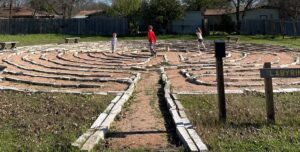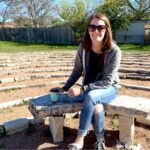by Emily P. Freeman
Ten years ago, on the first day of Lent, I met with a spiritual director for the first time. I wasn’t sure what to expect but I held on to hope that she would somehow be able to accompany me through new, unfamiliar terrain. One of the first things she did was read from a book of reflections by Macrina Wiederkehr, and as I listened, I was grateful for the space. It allowed me to close my eyes, settle in, and focus on a third element: something that wasn’t me but also wasn’t her.
Now that I serve as a spiritual director, I have my own stack of favorite resources I like to read from in order to provide a similar third element for directees (Parker Palmer calls these “third things”). Here are a few of my favorites, starting with one my spiritual director introduced me to on that first day we met:
Seasons of Your Heart by Macrina Wiederkehr
Drawing from her experience as a Benedictine nun, Wiederkehr writes reflective meditations inspired by the seasons. Combining lyrical prose and simple poems, her writing offers accessible metaphors for faith, wonder, and the mystery of God.
Slowly she celebrated the sacrament of letting go
First she surrendered her green, then orange, yellow, and red
Finally she let go of her brown
shedding her last leaf
she stood empty and silent, stripped bare
leaning against the sky she began her vigil of trust.
—An excerpt from The Sacrament of Letting Go
To Bless the Space Between Us by John O’Donohue
A collection of blessings that put language to some of life’s most poignant moments: desire for freedom, meeting a stranger, starting again, and saying goodbye. O’Donohue submits that blessing is a way of life, and I’ve found his offerings to be a welcome reframe of spirituality without the trigger words.
When you travel,
A new silence
Goes with you,
And if you listen,
You will hear
What your heart would
Love to say.
—An excerpt from For the Traveler
Guerillas of Grace by Ted Loder
Rather than reflections or blessings, this is an entire book of prayers: for thanks, for reassurance, and for comfort to name a few. One of my favorite prayers to use in spiritual direction comes from this book. It’s called Gather Me to Be with You and I find it to be beautifully grounding, especially at the beginning of a session.
O God, gather me now
To be with you
As you are with me.
Soothe my tiredness;
Quiet my fretfulness;
Curb my aimlessness;
Relieve my compulsiveness;
Let me be easy for a moment.
—An excerpt from Gather Me to Be With You
Beginning with a reading may not always be appropriate or necessary, and a third thing may sometimes be something other than words, like a painting, an image, or a song. I find it especially meaningful when a directee brings their own third thing into the room, sharing something that has meaning to them in their own walk with God. Mostly I’m grateful for third things, as they are a welcome reminder of the many ways God is always speaking to us.

















